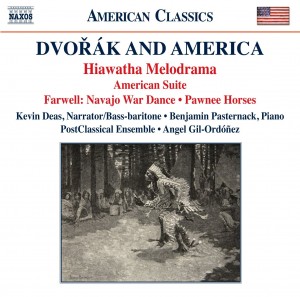
Is Dvorak’s New World Symphony a programmatic Hiawatha symphony? With the Dvorak scholar Mike Beckerman, I’ve composed a 35-minute Hiawatha Melodrama for narrator and orchestra that combines Dvorak with verses from Henry Wadsworth Longfellow’s The Song of Hiawatha. A new Naxos CD, “Dvorak and America,” includes the world premiere recording, with PostClassical Ensemble conducted by Angel Gil-Ordonez. Here’s movement five, in which “The Hunting of Pau-Puk-Keewis” aligns with the finale of Dvorak’s symphony:
Dvorak himself cited The Song of Hiawatha as a source of inspiration for his American symphony of 1893. Beckerman has closely studied points of correspondence between episodes of the symphony and episodes of Longfellow’s poem. He’s also demonstrated that the Larghetto from Dvorak’s Violin Sonatina is a portrait of Minnehaha, Hiawatha’s wife.
Our Melodrama is in five movements:
1.A spoken Prologue
2.Hiawatha’s Wooing (the music of which mainly draws on the Larghetto)
3.Hiawatha’s Wedding Feast (which presents the Scherzo from Dvorak’s symphony as a tone poem)
4.The Dearth of Minnehaha (using Dvorak’s Largo)
5.The Hunting of Pau-Puk –Keewis (Dvorak’s finale)
6.Epilogue: Hiawatha’s Departure (applying the coda of Dvorak’s symphony, which with its dirge and apotheosis can only be programmatic)
Our first goal in creating the Hiawatha Melodrama is to create a viable concert work. As a work of scholarship, the Melodrama suggests what a Hiawatha opera or cantata by Dvorak might have sounded like (and Dvorak wanted to compose a Hiawatha opera or cantata). Finally, the Melodrama apprises us what images and stories were in Dvorak’s head when he composed his symphony. Certainly Dvorak powerfully empathized with the fate of the Indian, and of the African-American – and, however subliminally, this element of compassion is at the root of the symphony’s enduring appeal.
By way of exploring Dvorak’s American style, the same Naxos CD includes Dvorak’s American Suite, the Larghetto from the Violin Sonatina, and a couple of Humoresques – as well as three terrific Indianist cameos by Arthur Farwell, who called himself the first composer “to take up Dvorak’s challenge.”
That Dvorak became an American composer during his astounding New World sojourn of 1892 to 1895 can no longer be doubted or denied.

I would be hesitant to enjoy your conclusions unless I knew you had studied all possible sources, including my father’s ground-breaking thesis on Dvorak’s time spent in Iowa and his exposure to American Indian music.
Saul! We’d love to hear about your father’s thesis. What was your father’s name and where can we get ahold of the thesis?? michael.beckerman@nyu.edu
Cheers,
Mike